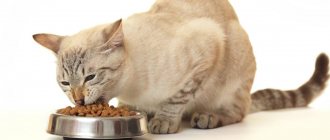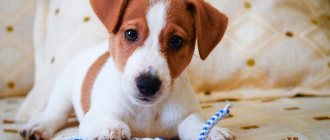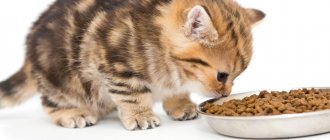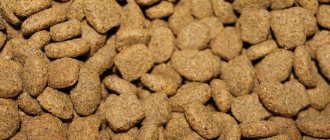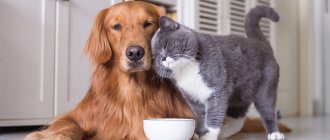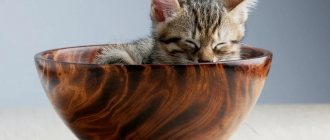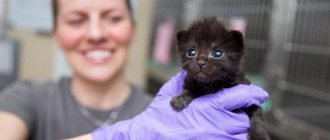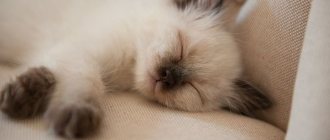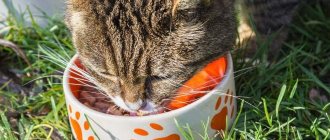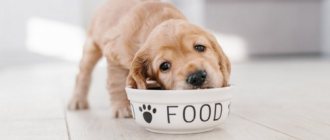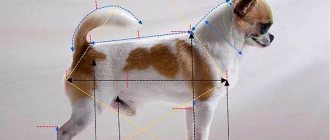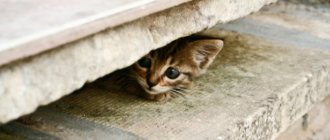7300Pavel
5
Some cat owners, especially those who are still inexperienced, choose dry food because of the apparent ease of use: the pet just needs to have a bowl into which food needs to be poured twice a day in the right quantity. All that remains is to make sure that there is fresh water in the other one - and no hassle. In fact, the question of how to properly feed a cat dry food is much more complicated.
With this feeding method, it is very important to take care of the animal’s health and follow several feeding recommendations from professionals.
© shutterstock
Rule one - don't mix
Some owners, feeling sorry for their pet, dilute its dry diet with natural food, which, in their opinion, is healthy. This is how pork cutlets, smoked meats, salted fish appear in the bowl - that is, everything that is actually contraindicated for cats. When pets develop problems with the liver and pancreas, there is a high degree of probability that the reason lies precisely in how the owners preferred to feed them.
In addition, there is another reason why you cannot give homemade food and dry food at the same time - they are digested using different enzymes. The amount of gastric juice also differs. Therefore, mixing these types of nutrition puts a double burden on both the stomach and the liver.
A separate topic concerns mixing dry and wet nutrition. There is no consensus on this matter, but in principle it is possible to periodically give canned food (best from one manufacturer). It is important to ensure that they make up no more than a quarter of the daily diet. The problem with wet food is that cats love it much more, which is why they tend to overeat - and this is a direct path to dangerous obesity.
What foods can you feed a kitten?
Remember that the food you put in your kitten's bowl should never be hot or cold. It is optimal if the food is at room temperature.
It is important to remember the consistency of food - it is better if the first portions are mushy and do not contain solid pieces. At home, a blender or an ordinary grater for milking vegetables will help with this.
So, what to feed a kitten:
- Meat. It can be raw, boiled, frozen and scalded. 60-80% of a kitten's daily diet comes from lean meat. What kind of meat is suitable for a kitten - see the table below;
- Liver. Offered once every 1-2 weeks;
- Porridge. In their pure form, the kitten is unlikely to be interested in them, but adding meat or vegetables radically changes the matter. Mix porridge with meat in a 1:2 ratio;
- Vegetables. Fresh or boiled;
- Eggs. What do kittens eat from eggs? Exclusively yolk. It is useful to give a raw yolk to a kitten once a week. Pay special attention to quail eggs - they are very healthy and quail eggs can be given whole, without separating the white from the yolk;
- Fermented milk products with low fat content;
- Brewer's yeast;
- Oil. Experts recommend avoiding vegetable oil and replacing it with Vaseline.
Rule two - only the best
To properly feed your cat dry food, you need to choose only the super premium category.
© shutterstock
Cheap ready-made food has a number of significant disadvantages:
- made from completely useless parts of animals and birds - hooves, feathers, bones are processed for it;
- This food contains a lot of gluten, and this is completely unacceptable, since it is one of the most powerful cat allergens.
So economy-class food poses a direct threat to the cat’s health.
Mixed feeding – harm or benefit?
Some breeders decide to use mixed feeding. This diet involves the simultaneous consumption of ready-made food and natural food.
Such feeding will do more harm than good:
- The intestines digest natural food after 1.5-2 hours have passed. At this time, the finished product is in the pet’s stomach. This process has a negative impact on the digestive system.
- Any mixed diet will eventually lead to diseases of the digestive system.
Breeders note that when mixing feed, the animal may completely abandon natural ingredients.
Rule three - water must be present
Moreover, the water is clean and always fresh. Some owners, again showing dubious concern for their pet, replace it with milk. However, this should not be done with an adult cat, otherwise he will have problems with the gastrointestinal tract.
The volume of fluid is also important - if you feed your cat dry food, you need to triple the daily amount recommended by veterinarians. In this case, it is calculated depending on the amount of feed: it should be three times more.
There are cats that drink little, for whom choosing unmoistened food can even be dangerous. If you cannot give canned food for some reason, you need to pre-soak dry cat food in the appropriate proportion. It turns out to be a kind of soup: at first the animal may refuse it, but if you are persistent, it will gradually get used to it and feeding it will become easier.
Types of feed: how to make the right choice?
The most expensive and high-quality food does not contain artificial food additives.
There is food for cats from different manufacturers. They are divided into 4 classes:
- Holistic. Developed by professionals of the highest category. Refers to the best type of feed. Does not contain flavor enhancers (digests). High price. Popular companies: Innova;
- Golden Eagle Holistic;
- GO and NOW Natural holistic;
- Orijen;
- Acana et al.
- Nero Gold;
- Belcando;
Rule four - give exactly as much food as required
The packaging of good food always indicates how much dry cat food should be given. Gullible owners think that the portions are calculated by experts and are exactly suitable for an animal of this weight and age. However, in fact, even the best producers are often cunning, because they are interested in running out of food faster and, accordingly, buying it again.
© shutterstock
You can and should use the sign, but with your own little trick - in your mind, reduce the cat’s weight by a kilogram and feed him the same portion of food as if he really weighed less. Such advice will help keep the animal's health in order and protect it from overeating - and, accordingly, obesity again.
For the same reason, it is better to check the volume of the food measuring cup - and these are often included with the packaging - on a kitchen scale. Sometimes owners overfeed their pets and don’t know it themselves.
The need for vitamins
Any vitamin and mineral complexes can be given to cats only as prescribed by a doctor. An excess of active substances is no less harmful than their lack.
When feeding your pet a complete diet, supplements are usually not required as it contains everything needed. Owners do not even have to separately provide a special paste for removing lint; it is present in types of food for long-haired breeds (the packaging should be marked “hairball”).
Strictly prohibited, this is for the people
Rule five - do not change the food (if possible)
Cats are not people; they do not get bored with a monotonous diet; moreover, feeding them canned and dry food is useful for them, since the cat’s delicate stomach gets used to food, and the animal gets sick much less often.
If for some reason you still need to change the food, then the change must be made gradually and after consultation with a veterinarian, who will suggest the correct regimen.
In general, a two-week transition scheme is used, which looks like this: at the first feeding, 20% of the new food is added, then with each feeding (and you need to feed twice a day), a little more is added until the old one is completely replaced. This is also useful for the reason that in the process you can observe how the cat’s body reacts to such changes. It may be worth choosing something else - this need is indicated by diarrhea, constipation, and other atypical reactions to food.
© shutterstock
It is very important not to change it during some stressful period of life for the cat - otherwise he will associate such a change with unpleasant sensations and will have a negative attitude towards the new food.
What to do if you stop eating
If your pet suddenly refuses to eat its usual food, you must first find out the reason for this behavior. First of all, you need to check whether the product has deteriorated.
This may occur due to violation of storage rules or expiration date. In this case, you should immediately throw away the food and buy a new bag.
Perhaps the granules stopped attracting the cat because they lay in the bowl for too long and “fizzled out.” Cats have few taste buds on their tongues; the main thing for them is the smell; if some of it is lost, the fuzzy fussy cat will lose interest in the dish. To correct the situation, just add a little fresh food and your appetite will be restored.
Another reason for refusing to eat may be the pet receiving excess treats or snacks during the day. Seals sometimes become capricious when fed a mixed type of feeding, thus begging for pouches or pates. To return to the established diet, you should temporarily exclude all “goodies” and offer only “drying” (twice a day) and water.
Cats eat less after suffering stress (for example, moving), in extreme heat. Females lose their appetite during estrus, males - during the period of sexual heat. These disorders go away on their own over time. To prevent eating disorders, your pet needs to be calmed, cuddled, and given access to fresh water. It is advisable to castrate individuals not participating in breeding. This will help avoid many pet health problems and most behavioral disorders. You also need to keep your cat's dishes clean; squeamish cats won't eat from a dirty bowl.
The situations listed above are not a cause for concern. But, a decrease (or loss) of interest in food is accompanied by most serious diseases of domestic animals. You need to be especially careful when food refusal is accompanied by:
- increased temperature;
- vomiting;
- lethargy;
- desire to hide;
- diarrhea;
- discharge from the nose or eyes;
- constipation;
- skin rashes;
- deterioration in wool quality.
If your cat exhibits at least one of the listed symptoms, you need to visit a veterinary clinic as soon as possible. In most cases, the success of treatment depends on how quickly it is started.
These are not crackers, this is a complete food
